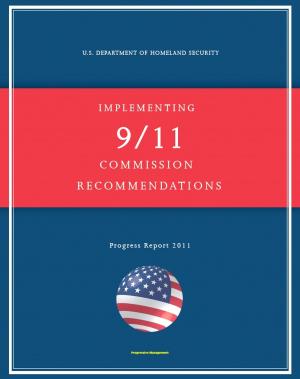Unconventional Restraint: Obstacles to Army Special Operations Forces' Employment in Support to Resistance Operations - ARSOF STR Irregular Warfare and Case Study of Syria, Assad and ISIS
Nonfiction, History, Military, Strategy| Author: | Progressive Management | ISBN: | 9780463882610 |
| Publisher: | Progressive Management | Publication: | June 21, 2018 |
| Imprint: | Smashwords Edition | Language: | English |
| Author: | Progressive Management |
| ISBN: | 9780463882610 |
| Publisher: | Progressive Management |
| Publication: | June 21, 2018 |
| Imprint: | Smashwords Edition |
| Language: | English |
This important December 2017 report has been professionally converted for accurate flowing-text e-book format reproduction.
Despite ever-increasing political support to U.S. Army Special Operations Forces (ARSOF) in the 21st century, enduring obstacles continue to limit the execution of support to resistance movements as a viable strategic policy option for the United States. When both diplomatic and conventional military options prove too costly and/or reach an impasse, the National Command Authority is left with two options: do nothing or force a change by supporting elements of the indigenous opposition.
Recent history provides several examples of presidential decisions to leverage U.S. military support to resistance movements (STR) to, as outlined in Joint Publication 3-05, Special Operations (2014), "coerce, disrupt or overthrow a government or occupying power" in Afghanistan, Iraq, Libya, and most recently, Syria. Yet the efficacy of this core activity remains constrained by legal, political, and organizational challenges. This study explores both the causes and depths of these obstacles to the employment of ARSOF elements in support to indigenous resistance activities and identifies feasible means to overcome these hurdles. Ultimately, recognition and alleviation of these obstacles will optimize ARSOF's activities and arm national policymakers with the ways and means to achieve long-lasting policy ends.
I. INTRODUCTION AND BACKGROUND * II. LITERATURE REVIEW * A. VIABILITY OF STR AS A STRATEGY * B. MODERN CONFLICT PARADIGM * C. POLITICAL AND LEGAL CHALLENGES TO STR * D. ORGANIZATIONAL CHALLENGES TO STR * E. TRAINING AND EDUCATIONAL CHALLENGES TO STR * III. APPROACH/METHODOLOGY * A. SUPPORT TO RESISTANCE MOVEMENTS VERSUS UNCONVENTIONAL WARFARE * B. TRADITIONAL WARFARE VERSUS IRREGULAR WARFARE * C. INDIRECT APPROACH VERSUS DIRECT APPROACH * D. SPECIAL WARFARE VERSUS SURGICAL STRIKE * E. COMBATING TERRORISM VERSUS COUNTERTERRORISM * IV. PREMISE 1: STR IS A VIABLE OPTION * A. A HISTORY OF FAILURE? * B. THE "MAGIC BULLET" FALLACY * C. SHORT-TERM SUCCESS, LONG-TERM FAILURE, AND WINNING THE "DAY AFTER" * D. CONCLUSION * V. PREMISE 2: MODERN CONFLICT PARADIGM CHANGE * A. CHINA * B. RUSSIA * C. IRAN * D. SIMILAR REFLECTIONS WITHIN U.S. DOCTRINE * E. CONCLUSION * VI. LEGAL OBSTACLES * A. INTERNATIONAL LEGAL CONSIDERATIONS * B. DOMESTIC LEGAL CONSIDERATIONS * C. SUMMARY * VII. POLITICAL OBSTACLES * A. CHALLENGES OF BRIDGING CIVIL-MILITARY DISCONNECTION THROUGH A GLOBAL SOF NETWORK * 1. SOF'S Global Network to Improve the Civil-Military Disconnect * 2. Impediments to the Global SOF Network's Effectiveness * B. SUBJECTIVE ORGANIZATION AND MANAGEMENT OF THE NSC PROCESS * C. POLITICAL RISK AVERSION * D. GEOPOLITICS * E. SUMMARY * VIII. ORGANIZATIONAL OBSTACLES * A. OFFICE OF STRATEGIC SERVICES ORGANIZATIONAL DESIGN ANALYSIS * B. COMPARATIVE ANALYSIS OF THE OSS AND ITS DESCENDANTS * C. SOF-CIA RELATIONSHIP: DIVERGENCE AND CONVERGENCE AMONG OSS DECEDENTS * D. SUMMARY * IX. SYRIA CASE STUDY * A. LEGAL OBSTACLES TO U.S. INTERVENTION IN SYRIA * B. POLITICAL OBSTACLES TO U.S. INTERVENTION IN SYRIA * C. ORGANIZATIONAL OBSTACLES TO U.S. INTERVENTION IN SYRIA * D. SUMMARY * E. WHAT IF? * 1. Phase One: Assad Must Go * 2. Phase Two: ISIS Must Go * X. CONCLUSION/RECOMMENDATIONS * A. RECOMMENDATION #1: ADVOCATE FOR THE INCORPORATION OF IRREGULAR WARFARE WITHIN THE NATIONAL SECURITY STRATEGY * B. RECOMMENDATION #2: ESTABLISH AN IRREGULAR WARFARE WORKING GROUP WITHIN THE NSC * C. RECOMMENDATION #3: CONTINUE THE MOMENTUM FOR STANDING CONGRESSIONAL AUTHORIZATION AND FUNDING SUPPORTING IRREGULAR WARFARE * D. RECOMMENDATION #4: ACKNOWLEDGE THE CONVERGENCE OF DOD AND THE CENTRAL INTELLIGENCE AGENCY AS A MODERN NECESSITY AND REFORM LEGISLATION AND ORGANIZATIONAL PRACTICES ACCORDINGLY * E. RECOMMENDATION #5: REFORM SOF EDUCATION FOR SPECIAL WARFARE AND NON-SOF PERSONNEL * F. FURTHER RESEARCH
This important December 2017 report has been professionally converted for accurate flowing-text e-book format reproduction.
Despite ever-increasing political support to U.S. Army Special Operations Forces (ARSOF) in the 21st century, enduring obstacles continue to limit the execution of support to resistance movements as a viable strategic policy option for the United States. When both diplomatic and conventional military options prove too costly and/or reach an impasse, the National Command Authority is left with two options: do nothing or force a change by supporting elements of the indigenous opposition.
Recent history provides several examples of presidential decisions to leverage U.S. military support to resistance movements (STR) to, as outlined in Joint Publication 3-05, Special Operations (2014), "coerce, disrupt or overthrow a government or occupying power" in Afghanistan, Iraq, Libya, and most recently, Syria. Yet the efficacy of this core activity remains constrained by legal, political, and organizational challenges. This study explores both the causes and depths of these obstacles to the employment of ARSOF elements in support to indigenous resistance activities and identifies feasible means to overcome these hurdles. Ultimately, recognition and alleviation of these obstacles will optimize ARSOF's activities and arm national policymakers with the ways and means to achieve long-lasting policy ends.
I. INTRODUCTION AND BACKGROUND * II. LITERATURE REVIEW * A. VIABILITY OF STR AS A STRATEGY * B. MODERN CONFLICT PARADIGM * C. POLITICAL AND LEGAL CHALLENGES TO STR * D. ORGANIZATIONAL CHALLENGES TO STR * E. TRAINING AND EDUCATIONAL CHALLENGES TO STR * III. APPROACH/METHODOLOGY * A. SUPPORT TO RESISTANCE MOVEMENTS VERSUS UNCONVENTIONAL WARFARE * B. TRADITIONAL WARFARE VERSUS IRREGULAR WARFARE * C. INDIRECT APPROACH VERSUS DIRECT APPROACH * D. SPECIAL WARFARE VERSUS SURGICAL STRIKE * E. COMBATING TERRORISM VERSUS COUNTERTERRORISM * IV. PREMISE 1: STR IS A VIABLE OPTION * A. A HISTORY OF FAILURE? * B. THE "MAGIC BULLET" FALLACY * C. SHORT-TERM SUCCESS, LONG-TERM FAILURE, AND WINNING THE "DAY AFTER" * D. CONCLUSION * V. PREMISE 2: MODERN CONFLICT PARADIGM CHANGE * A. CHINA * B. RUSSIA * C. IRAN * D. SIMILAR REFLECTIONS WITHIN U.S. DOCTRINE * E. CONCLUSION * VI. LEGAL OBSTACLES * A. INTERNATIONAL LEGAL CONSIDERATIONS * B. DOMESTIC LEGAL CONSIDERATIONS * C. SUMMARY * VII. POLITICAL OBSTACLES * A. CHALLENGES OF BRIDGING CIVIL-MILITARY DISCONNECTION THROUGH A GLOBAL SOF NETWORK * 1. SOF'S Global Network to Improve the Civil-Military Disconnect * 2. Impediments to the Global SOF Network's Effectiveness * B. SUBJECTIVE ORGANIZATION AND MANAGEMENT OF THE NSC PROCESS * C. POLITICAL RISK AVERSION * D. GEOPOLITICS * E. SUMMARY * VIII. ORGANIZATIONAL OBSTACLES * A. OFFICE OF STRATEGIC SERVICES ORGANIZATIONAL DESIGN ANALYSIS * B. COMPARATIVE ANALYSIS OF THE OSS AND ITS DESCENDANTS * C. SOF-CIA RELATIONSHIP: DIVERGENCE AND CONVERGENCE AMONG OSS DECEDENTS * D. SUMMARY * IX. SYRIA CASE STUDY * A. LEGAL OBSTACLES TO U.S. INTERVENTION IN SYRIA * B. POLITICAL OBSTACLES TO U.S. INTERVENTION IN SYRIA * C. ORGANIZATIONAL OBSTACLES TO U.S. INTERVENTION IN SYRIA * D. SUMMARY * E. WHAT IF? * 1. Phase One: Assad Must Go * 2. Phase Two: ISIS Must Go * X. CONCLUSION/RECOMMENDATIONS * A. RECOMMENDATION #1: ADVOCATE FOR THE INCORPORATION OF IRREGULAR WARFARE WITHIN THE NATIONAL SECURITY STRATEGY * B. RECOMMENDATION #2: ESTABLISH AN IRREGULAR WARFARE WORKING GROUP WITHIN THE NSC * C. RECOMMENDATION #3: CONTINUE THE MOMENTUM FOR STANDING CONGRESSIONAL AUTHORIZATION AND FUNDING SUPPORTING IRREGULAR WARFARE * D. RECOMMENDATION #4: ACKNOWLEDGE THE CONVERGENCE OF DOD AND THE CENTRAL INTELLIGENCE AGENCY AS A MODERN NECESSITY AND REFORM LEGISLATION AND ORGANIZATIONAL PRACTICES ACCORDINGLY * E. RECOMMENDATION #5: REFORM SOF EDUCATION FOR SPECIAL WARFARE AND NON-SOF PERSONNEL * F. FURTHER RESEARCH















